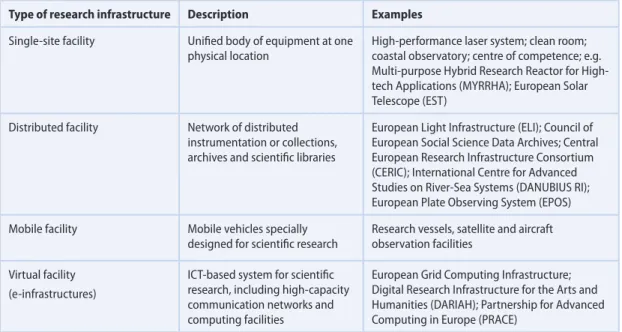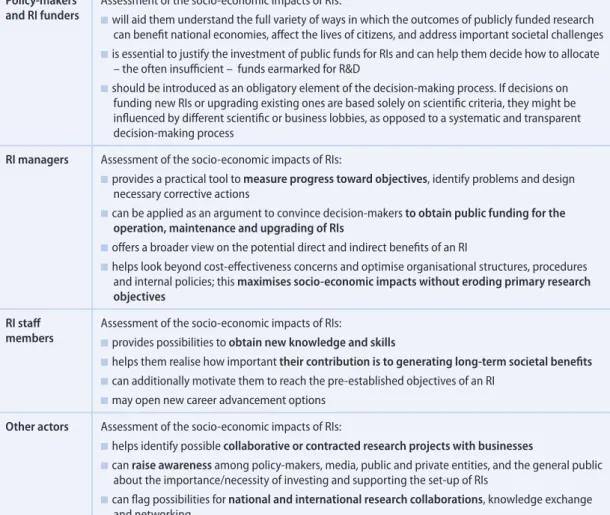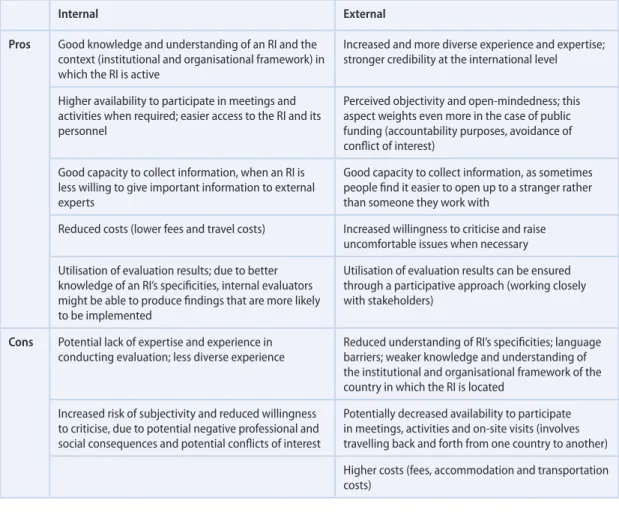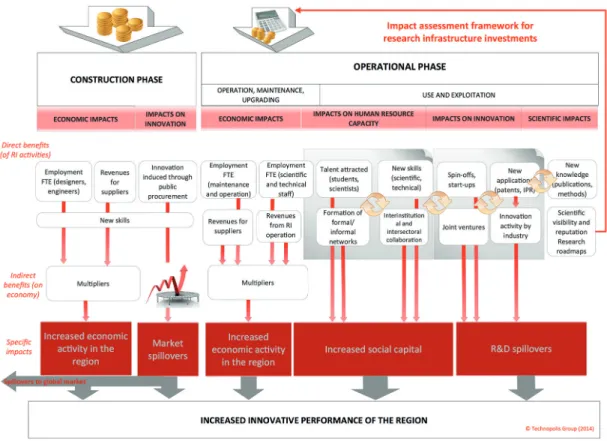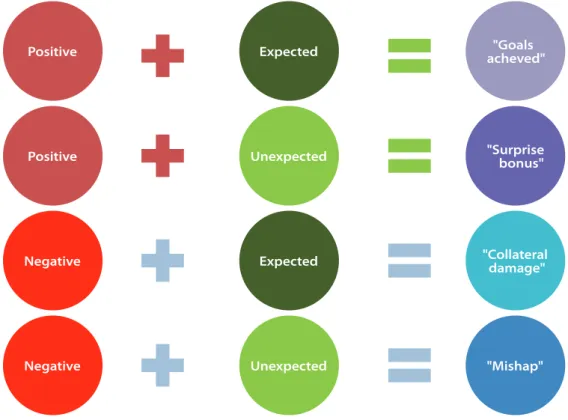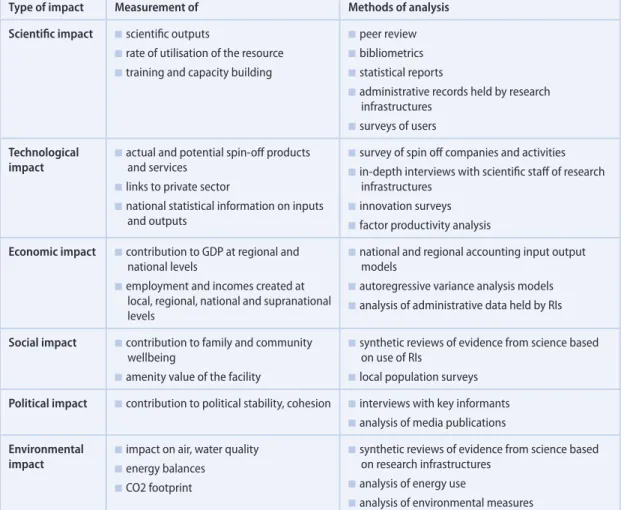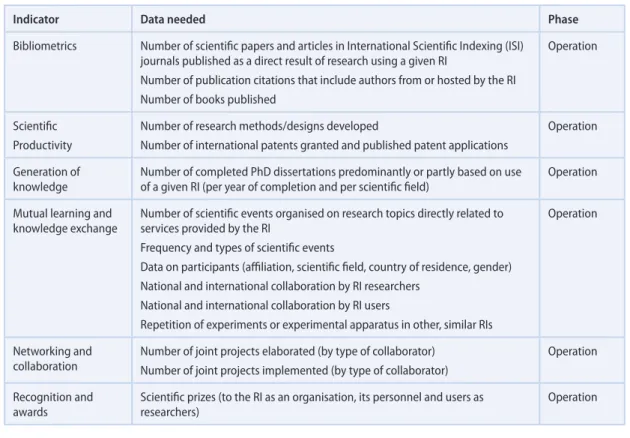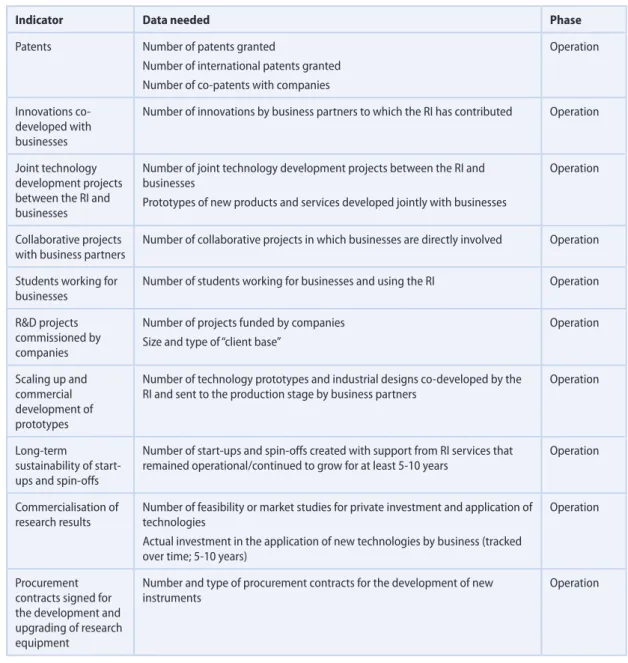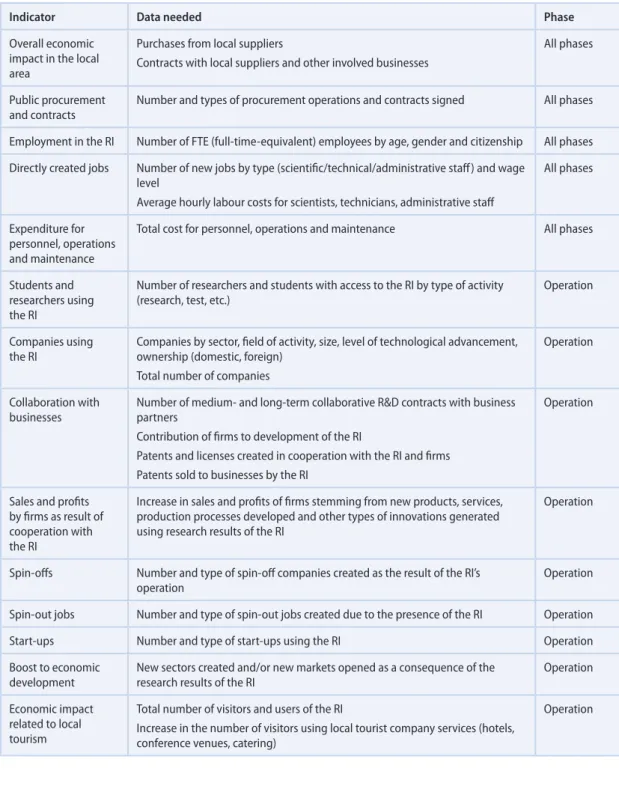ResInfra@DR
A Practical Guide:
Assessment of Socio-Economic
Impacts of Research
Infrastructures
A PRACTICAL GUIDE:
ASSESSMENT OF
SOCIO-ECONOMIC IMPACTS OF RESEARCH INFRASTRUCTURES
ResInfra@DR
PUBLISHER AND EDITOR:
ResInfra@DR project c/o Centre for Social Innovation Linke Wienzeile 246, A-1150 Wien
institute@zsi.at
MAIN AUTHOR: Marko Hajdinjak (ARC Fund) EDITOR: Attila Havas (CERS HAS)
ACKNOWLEDGEMENTS: We thank all project partners who contributed to this publication. The feedback and other contributions provided by participants of the ResInfra@DR Concluding Consul- tation Meeting, held in Budapest on 27-28 November 2018, are gratefully acknowledged.
TECHNICAL EDITOR: Pamela Bartar (ZSI) LANGUAGE EDITOR: Maureen Patricia McNeill DESIGN: Krassimir Apostolov
YEAR OF PUBLICATION: 2019
Project Acronym ResInfra@DR
Project full title Facilitating macro-regional scope and link up to socio-economic actors of Research Infrastructure in the Danube Region
Funding Scheme Interreg Danube DTP Project start date 01/01/2017 Project duration 30 months
Project partners Centre for Social Innovation (ZSI) – Coordinator (Austria);
University of Natural Resources and Life Sciences, Vienna (Austria);
Applied Research and Communications Fund, Ministry of Education (Bulgaria);
Ministry of Education and Sports (Croatia);
Institute of Philosophy, Czech Academy of Sciences (Czech Republic);
Centre for Economic and Regional Studies, Hungarian Academy of Sciences (Hungary);
Executive Agency for Higher Education, Research, Development and Innovation Funding (Romania);
Slovak Centre of Scientifi c and Technical Information (Slovakia);
Ministry for Scientifi c and Technological Development, Higher Education and Information Society of Republic of Srpska (Bosnia and Herzegovina);
Ministry of Education, Science and Technological Development (Serbia);
Central European Initiative Executive Secretaria (Italy);
National Authority for Scientifi c Research and Innovation (Romania);
Academy of Sciences of Moldova (Moldova) Contact offi ce@resinfradr.eu
ResInfra@DR is co-funded by European Union funds (ERDF, IPA) and the Government of Hungary.
TABLE OF CONTENTS
EXECUTIVE SUMMARY 4
1 INTRODUCTION 6
2 ORGANISING AND MANAGING A SOCIO-ECONOMIC IMPACT ASSESSMENT OF RIS 9
3 TYPICAL CHALLENGES AND LIMITATIONS OF IMPACT ASSESSMENTS 11
31 Availability of relevant data and the relevance of available data 12
32 The impact is known – but who did it? (Attribution of impact) 12
33 Smoke without fire – the problem of unfulfilled potential 13
34 From zero to hero – the long delay 14
35 All different – all unique: Particularities and specific features 14
36 Alone in the desert – context and preconditions for successful RI operation 14
4 TYPES OF SOCIO-ECONOMIC IMPACTS OF RIS 15
41 Expected and unexpected impacts 15
42 Scientific impact 17
43 Technological impact and impact on innovation 17
44 Direct and indirect economic impacts 17
45 Impact on human resources 17
46 Societal impacts 18
REFERENCES 19
ANNEX I: INDICATORS FOR ASSESSMENT OF THE SOCIO-ECONOMIC IMPACTS OF RIS 21
ANNEX II: ASSESSMENT METHODS 26
GLOSSARY 35
ABBREVIATIONS 35
LIST OF TABLES AND FIGURES 36
Project Acronym ResInfra@DR
Project full title Facilitating macro-regional scope and link up to socio-economic actors of Research Infrastructure in the Danube Region
Funding Scheme Interreg Danube DTP Project start date 01/01/2017 Project duration 30 months
Project partners Centre for Social Innovation (ZSI) – Coordinator (Austria);
University of Natural Resources and Life Sciences, Vienna (Austria);
Applied Research and Communications Fund, Ministry of Education (Bulgaria);
Ministry of Education and Sports (Croatia);
Institute of Philosophy, Czech Academy of Sciences (Czech Republic);
Centre for Economic and Regional Studies, Hungarian Academy of Sciences (Hungary);
Executive Agency for Higher Education, Research, Development and Innovation Funding (Romania);
Slovak Centre of Scientifi c and Technical Information (Slovakia);
Ministry for Scientifi c and Technological Development, Higher Education and Information Society of Republic of Srpska (Bosnia and Herzegovina);
Ministry of Education, Science and Technological Development (Serbia);
Central European Initiative Executive Secretaria (Italy);
National Authority for Scientifi c Research and Innovation (Romania);
Academy of Sciences of Moldova (Moldova) Contact offi ce@resinfradr.eu
ResInfra@DR is co-funded by European Union funds (ERDF, IPA) and the Government of Hungary.
EXECUTIVE SUMMARY
The ResInfra@DR project has aimed at upgrading the knowledge of policy-makers and policy delivery organisations involved in the funding of research infrastructures (RIs), and RI managers.
Thus, it has facilitated a dialogue process for RI stakeholders in the Danube macro-region; organised training workshops for RI policy-makers, managers and reviewers; compiled a registry of competent reviewers for RI evaluations; and arranged pilot peer learning activities to help existing RIs improve their operations and planned RIs to fine tune their investment plan and business model.
For a more detailed account of these activities and their results, please consult: http://www.interreg-danube.eu/approved-projects/resinfra-dr
The project has produced three guidance documents for RI policy-makers, managers and reviewers on ex ante evaluation, monitoring and assessment of the socio-economic impact of RIs, thus cover- ing the life cycle of RIs.
Life cycle of RIs, the relevance of ex ante evaluation, monitoring and socio-impact assessment at different stages of the life cycle
Ex ante
evaluation Monitoring
of operation Assessing socio- economic impacts
Operation &
Service
Preparation
&
Planning
Operation phase Establishment
Constructionor
Design and Establishment phase
Socio-economic impacts
These guides, including this one, have been developed by the ResInfra@DR consortium with input from RI policy-makers, managers and reviewers at several workshops and a concluding consultation meeting. Together, these three documents aim to provide an overview of the relevant processes and methods to improve the management of RIs leading to better utilisation of their precious and unique capacities, enhance performance, and pronounced socio-economic impacts.
This document, intended for RI policy-makers, funding agencies, RI managers, and other relevant ac- tors, considers the major aspects of assessing the socio-economic impacts of RIs. Social and econom- ic impacts are often assessed separately and with different methods, but in fact they are complemen- tary and sometimes overlap, which explains the importance of following an integrated approach, which can produce comprehensive information on these aspects in a cost-effective way.
The main purpose of socio-economic impact assessment is to prove to society that RIs bring bene- fit to the entire society and that their relevance goes far beyond pure science. It also helps RI manag- ers in setting strategic directions; thus it is recommended an assessment to be conducted every 4-5 years. RI managers and policy-makers, however, face several challenges when organising or commis- sioning an assessment. First, there is no ‘blueprint’ or ‘easy-to-follow’ manual for assessing RIs: there is no set of methods or indicators that would be automatically appropriate for every RI; each RI needs to be understood first, and then assessed in its own context. Second, ex ante evaluation, monitoring and the assessment of socio-economic impacts are closely interlinked. There are at least two precon- ditions for a useful assessment exercise. The intervention logic of a given RI – why investment is need- ed, what impact can be expected and through what mechanisms – needs to be clarified as part of an ex ante evaluation. Further, an appropriate monitoring system should be in place not only for the purpose of monitoring, but also to systematically collect relevant data for socio-economic impact as- sessment. Third, timing is crucial: to measure certain impacts, one might need to wait. Fourth, some RI managers and/or researchers may be reluctant to engage in assessment exercises. However, as- sessment is a must, as RIs are funded by public money. Fifth, the evaluation culture in general is weak in quite a few countries, including several in the Danube macro-region, hence the required method- ological skills are missing or not yet sufficiently developed. Assessing the socio-economic impacts of RIs is a necessity even in these countries, for the above reason. Learning by doing can contribute to developing missing capacities and skills.
1 INTRODUCTION
This guide is one of five documents intended to enhance the utilisation of research infrastructures (RIs) in Danube macro-region countries. The documents include three practical guides (on ex ante evaluation, monitoring and assessment of the socio-economic impacts of RIs) and two sets of recom- mendations (one for RI policy-makers and one for managers).
The current document proposes some practical guidelines for assessing the socio-economic impacts of RIs. It presents different types of impacts and some relevant questions to evaluate them, lists the typical indicators used to assess different impacts, and proposes ways to collect data for these indi- cators. The guide also discusses how to organise and manage the process of assessing the socio-eco- nomic impacts of RIs.
It needs to be noted that this guidance document was written with the intention to be accessible and useful for a very diverse audience, from RI policy-makers to managers to researchers in a broad spectrum of science domains. Hence, it cannot provide specific and tailor-made recommendations on how to evaluate particular socio-economic impacts related to each type of research infrastructure.
Nevertheless, it is intended to present assessment indicators, methods and processes that can be ap- plicable and relevant in numerous different contexts.
What do we understand as research infrastructures?
Research infrastructures need to be understood broadly, including all elements, which are indispen- sable for conducting scientific research and disseminating results: equipment, biobanks and oth- er banks of various materials, databanks, information systems, as well as human resources operating and using RIs. The variety of RIs is huge, and because they serve different research communities with complex research needs and objectives, each RI has its own specific characteristics.
Research infrastructures include:
Q Major equipment or sets of instruments used for research purposes;
Q Knowledge resources such as collections, archives, structured information or systems related to data management and used in scientific research;
Q Enabling information and communication technology-based infrastructure or ‘e-infrastructure’
such as grid, computing, and software communications;
Q Any other entity of a unique nature that is used to achieve excellence in research.
According to the level of maturity (life cycle), research infrastructures can be classified as:
Q Proposals for the establishment of research infrastructures (“concept development”);
Q RIs in the design phase;
Q RIs in the preparation phase;
Q RIs in the construction phase (“implementation phase”);
Q RIs in the operation phase;
According to their geographical scope/relevance, RIs are:
Q Regional;
Q National;
Q Macro-regional;
Q Pan-European.
TABLE 1: TYPOLOGY OF RESEARCH INFRASTRUCTURES ACCORDING TO THEIR STRUCTURE/
DISTRIBUTION
Type of research infrastructure Description Examples Single-site facility Unified body of equipment at one
physical location High-performance laser system; clean room;
coastal observatory; centre of competence; e.g.
Multi-purpose Hybrid Research Reactor for High- tech Applications (MYRRHA); European Solar Telescope (EST)
Distributed facility Network of distributed instrumentation or collections, archives and scientific libraries
European Light Infrastructure (ELI); Council of European Social Science Data Archives; Central European Research Infrastructure Consortium (CERIC); International Centre for Advanced Studies on River-Sea Systems (DANUBIUS RI);
European Plate Observing System (EPOS) Mobile facility Mobile vehicles specially
designed for scientific research Research vessels, satellite and aircraft observation facilities
Virtual facility (e-infrastructures)
ICT-based system for scientific research, including high-capacity communication networks and computing facilities
European Grid Computing Infrastructure;
Digital Research Infrastructure for the Arts and Humanities (DARIAH); Partnership for Advanced Computing in Europe (PRACE)
Source: Griniece E, A Reid, J Angelis, 2015, p 5
Why conduct an assessment of socio-economic impacts
Research infrastructures are primarily intended to facilitate research activities, but their societal rel- evance goes beyond the realm of pure research. The development of technologies, generation of knowledge and other activities of skilled researchers stimulate innovation, attract internal and exter- nal investment, and boost economic growth. This affects the economic, social and cultural life of a host region.
“An impact evaluation provides information about the impacts produced by an intervention - positive and negative, intended and unintended, direct and indirect. This means that an impact evaluation must establish what has been the cause of observed changes (in this case ‘impacts’).”
ESFRI – Long-Term Sustainability Working Group, 2017
Socio-economic impact assessment is a tool that aids in understanding a potential range of im- pacts by research infrastructures. The knowledge obtained through this assessment can contribute to the preparation of strategies to minimise the negative and maximise the positive impacts of RI’s activities. Assessment of socio-economic impacts is also necessary to obtain and justify the public
funding that RIs receive. For policy-makers, such assessment is very valuable in improving policies and programmes for planning, establishing and financing RIs.
As stated by ESFRI, national authorities and funding bodies “should be explicit about the role that so- cio-economic benefits play in their strategy and funding decisions, so that RI operators are aware of their significance and take appropriate action when developing strategy and operating models to enhance them in the future. Periodic monitoring of societal impact should be part of the regular assessment of RIs” (ESFRI – Long-Term Sustainability Working Group, 2017).
Further, RIs “should dedicate sufficient resources both to evaluate their value to the economy and socie- ty at large and to communicate this to targeted audiences, from the general public to policy- makers as part of local, national and European science-policy-society dialogues to gain acceptance and support at all levels” (ESFRI – Long-Term Sustainability Working Group, 2017).
The potential benefits of assessing the socio-economic impacts of RIs
TABLE 2: WHO BENEFITS FROM ASSESSMENT OF THE SOCIO-ECONOMIC IMPACTS OF RIS AND HOW?
Policy-makers
and RI funders Assessment of the socio-economic impacts of RIs:
Qwill aid them understand the full variety of ways in which the outcomes of publicly funded research can benefit national economies, affect the lives of citizens, and address important societal challenges
Qis essential to justify the investment of public funds for RIs and can help them decide how to allocate – the often insufficient – funds earmarked for R&D
Qshould be introduced as an obligatory element of the decision-making process. If decisions on funding new RIs or upgrading existing ones are based solely on scientific criteria, they might be influenced by different scientific or business lobbies, as opposed to a systematic and transparent decision-making process
RI managers Assessment of the socio-economic impacts of RIs:
Qprovides a practical tool to measure progress toward objectives, identify problems and design necessary corrective actions
Qcan be applied as an argument to convince decision-makers to obtain public funding for the operation, maintenance and upgrading of RIs
Qoffers a broader view on the potential direct and indirect benefits of an RI
Qhelps look beyond cost-effectiveness concerns and optimise organisational structures, procedures and internal policies; this maximises socio-economic impacts without eroding primary research objectives
RI staff
members Assessment of the socio-economic impacts of RIs:
Qprovides possibilities to obtain new knowledge and skills
Qhelps them realise how important their contribution is to generating long-term societal benefits
Qcan additionally motivate them to reach the pre-established objectives of an RI
Qmay open new career advancement options Other actors Assessment of the socio-economic impacts of RIs:
Qhelps identify possible collaborative or contracted research projects with businesses
Qcan raise awareness among policy-makers, media, public and private entities, and the general public about the importance/necessity of investing and supporting the set-up of RIs
Qcan flag possibilities for national and international research collaborations, knowledge exchange and networking
2 ORGANISING AND MANAGING A SOCIO-ECONOMIC IMPACT ASSESSMENT OF RIS
Socio-economic impact assessments can be performed both internally and externally. An internal assessment may be performed in a shorter timeframe than an external assessment. Internal assess- ments can also be conducted as part of the preparation for external assessments, as they can provide crucial input. In this case, a major task for external evaluators is to assess whether the data and con- clusions presented in an internal assessment report are credible and comprehensive.
External assessments can be performed by funding bodies if they have an in-house assessment unit that possesses the required skills and experience. Otherwise independent national and internation- al experts can be commissioned.
Even in large countries, with an advanced evaluation culture, it might be very useful to include for- eign experts in an assessment process mainly performed by national experts. In small(er) countries, especially those where evaluation traditions are weak, a leading role played by foreign experts is in- evitable. National experts’ contributions are also crucial, as a thorough understanding of a national (or regional) innovation system is key to a useful assessment.
TABLE 3: THE PROS AND CONS OF INTERNAL VS EXTERNAL EXPERTS
Internal External
Pros Good knowledge and understanding of an RI and the context (institutional and organisational framework) in which the RI is active
Increased and more diverse experience and expertise;
stronger credibility at the international level
Higher availability to participate in meetings and activities when required; easier access to the RI and its personnel
Perceived objectivity and open-mindedness; this aspect weights even more in the case of public funding (accountability purposes, avoidance of conflict of interest)
Good capacity to collect information, when an RI is less willing to give important information to external experts
Good capacity to collect information, as sometimes people find it easier to open up to a stranger rather than someone they work with
Reduced costs (lower fees and travel costs) Increased willingness to criticise and raise uncomfortable issues when necessary Utilisation of evaluation results; due to better
knowledge of an RI’s specificities, internal evaluators might be able to produce findings that are more likely to be implemented
Utilisation of evaluation results can be ensured through a participative approach (working closely with stakeholders)
Cons Potential lack of expertise and experience in
conducting evaluation; less diverse experience Reduced understanding of RI’s specificities; language barriers; weaker knowledge and understanding of the institutional and organisational framework of the country in which the RI is located
Increased risk of subjectivity and reduced willingness to criticise, due to potential negative professional and social consequences and potential conflicts of interest
Potentially decreased availability to participate in meetings, activities and on-site visits (involves travelling back and forth from one country to another) Higher costs (fees, accommodation and transportation costs)
For Danube macro-region countries it is strongly recommended to appoint external/internation- al experts to assess the socio-economic impacts of RIs. Of course, external experts need to work to- gether with internal experts, but the leader of the assessment team should be an external expert with sufficient experience and expertise. This will raise the cost of an assessment, but the benefits of a high-quality evaluation will be multiple and long-lasting. An assessment of socio-economic im- pacts is conducted only once every four to five years, and hence it pays off to ensure that it is con- ducted properly.
3 TYPICAL CHALLENGES AND LIMITATIONS OF IMPACT ASSESSMENTS
FIGURE 1: THE LONG AND WINDING ROAD TO IMPACT
Start of
operation Inputs Activities Outcome Results Impact
In recent years, several attempts have been made to propose a comprehensive and unified frame- work for assessing the socio-economic impacts of RIs, but most likely it will never be possible to come up with a ‘one-size-fits-all’ solution for mapping all socio-economic impacts. 1
Assessment of the socio-economic impacts of research infrastructures is a complex exercise that in- volves numerous challenges and hides several pitfalls. To begin with, as demonstrated by Figure 1, the road to visible and measurable impacts is very long and full of twists and turns.
Q Impacts can in most cases be observed only after several years of hard work and countless activities, and are not always imminent, even when the first (scientific) results and outcomes have already been achieved.
Q Often it can be very difficult to gather data about the impacts and verify these data.
Q An RI’s socio-economic impacts can be direct and indirect, intended and unintended, expected and unexpected, positive and negative.
Q The socio-economic impact of different RIs should never be compared, because each RI is unique. An assessment should, therefore, compare impacts only against the specific objectives of the given RI.
Q Socio-economic impacts are also heavily influenced by a large variety of external factors, and hence an RI can never be considered fully responsible either for the positive or the negative impacts of its work. Indicators, which are used to establish that a certain impact has occurred, are rarely able to provide a comprehensive explanation as to why the impact actually happened.
Q Some of the impacts may be produced by the indirect use of an RI, making it even more difficult to assess them.
Q Certain types of impacts are more relevant for some RIs and less for others. Each RI has to select the appropriate impacts, assessment methods and indicators based on its own specific goals, while also taking into consideration the strategic visions and heterogeneous objectives of its stakeholders.
1 Several models to evaluate the socio-economic impact of RIs have been developed by projects supported by the European Framework Programmes (FP7, H2020), see, for example, EVARIO, http://cordiseuropaeu/project/rcn/97196_enhtml; ERINA+, http://
cordiseuropaeu/project/rcn/95676_enhtml; and RIFI, http://cordiseuropaeu/project/rcn/91271_enhtml
Q Finally, it should never be forgotten that although they are very important, indicators for assessing the socio-economic impacts of RIs are only part of an entire set of indicators necessary for managing an RI.
All these challenges, however, should not discourage RI managers from engaging in assessing socio- economic impacts. Quite the contrary – such assessment is absolutely necessary. Most RIs are fund- ed by public money and socio-economic impact assessment is the best tool to prove to policy-mak- ers and the general public that RIs bring numerous benefits to the society and that their relevance goes far beyond pure science. Needless to say, an assessment also helps the RI managers plan the operation of their RI and secure its long-term financial sustainability.
3.1 Availability of relevant data and the relevance of available data
Challenge All RIs collect and provide information regarding their scientific and technological activity, but collecting and analysing information about socio-economic impacts is usually given far less attention.
Much of the data needed for socio-economic impact assessment (see Annex 1 for details) can only be obtained through dedicated, often costly methods (interviews, surveys, case studies).
In addition, many RIs have a supranational impact, making the systematic collection of data much more difficult than in cases where RIs have a local and regional impact.
Possible
solution Determining the values of selected indicators requires the regular collection of a wide range of data.
A significant part of the data needed to measure socio-economic impacts can – and indeed, should be – generated during day-to-day operations. These include:
QThe database of users (academic researchers, businesses and other users; domestic and foreign, etc.)
QThe database of students using the RI (the number of MA and PhD theses completed thanks to the use of a given RI, the number of PhD students and post-docs involved in projects conducted at the RI)
QThe number of RI staff giving lectures/courses at universities
QThe database of RI supplier contracts, including data on main characteristics of suppliers (local, regional, other domestic, foreign; size; type of product/service provided, etc.)
QThe number of external users, who are likely to use travel, accommodation and other local services (these data are required for further calculations/estimations).
Example The impact of RI on innovations – either for business purposes or solving societal challenges – is highly likely to be complex and obtained via multiple pathways. Therefore, it is necessary to carry out in-depth interviews with researchers, relevant business people and other users, and/or conduct surveys by sending carefully designed questionnaires to relevant partners, users, and analysts.
3.2 The impact is known – but who did it? (Attribution of impact)
Challenge The operation of large RIs can cause a number of positive and negative externalities. For instance, RIs cause positive externality if the turnover of nearby hotels or catering establishments increases as a result of the increased number of visiting scientists or scientific conferences. RIs can also cause negative externalities:
land loss, change in land value, congestion, greenhouse gas emissions etc. Such externalities should also be considered in assessing socio-economic impacts, but it is very challenging to establish to which extent the operation of an RI is responsible for the occurance of these externalities. Take for example one of the most important indicators – the number of new jobs created. Successful innovation activities undoubtedly lead to the creation of new jobs either at existing or newly established firms, but pieces of information about these developments are possessed by different actors, making it a demanding analytical task to identify and
Possible
solution When assessing the indicators listed in Annex 1, the role of multipliers must be considered, as they inevitably affect the impact of indicators. In order to achieve accurate assessment results, the application of quantitative methods should be supplemented with qualitative insights and validation.
Another important aspect is time; the longer the time which elapses between the first appearance of a result achieved by an RI and its practical application (either for business or societal goals), the more likely it is that other factors will also enter the picture, making it more difficult to attribute a certain practical impact to the specific result of a given RI. Without considering these external influences, the socio-economic impacts might be underestimated.
Example ELI-ALPS plans to pay special attention to the training of, and providing information to, secondary school teachers, as they influence students by passing on their knowledge. The course is open to active high school physics, biology and chemistry teachers. Clearly, the number of teachers who have participated in this special training is easy to obtain. However, the ultimate goal is to stimulate students to opt for STEM careers and information about the career paths of students is not easily accessible to ELI-ALPS and their evaluators.
Establishing a causal link between courses offered to teachers and the impact of those on the career choices of their students would require further detailed, complex, time-consuming, and expensive analyses.
3.3 Smoke without fire – the problem of unfulfilled potential
Challenge Research infrastructures are enablers. The knowledge, prototypes, discoveries, human capital, etc. which they produce represent an opportunity for their economic and social environment. However, if this environment does not have the capacity to use and further develop the opportunities delivered by the RIs, then the significant potential for their socio-economic impacts will remain partially or fully unfulfilled. In other words, the extent of socio-economic impact of a given RI depends on the quality of its immediate economic environment: the aspirations, strategies, skills and resources of those actors who can use the services and/or outcomes of RIs.
Possible solution
QAn assessment of the socio-economic impact of an RI must always take into consideration its limitations.
It is never possible to fully explore the extent to which socio-economic benefits are influenced by external activities and factors.
QA particular result/outcome of an RI’s activities might not produce any visible impact in the short or even medium term. However, it could have a considerable impact in the long run. It is therefore necessary to collect and store data regularly and over long periods.
QIn order to accurately assess RI-induced impacts, other determinants – such as parallel initiatives in higher education, support measures for enterprises and national legal frameworks – should be also studied (as much as possible).
Example Even a widespread and commonly used indicator such as patent citations suffers from some limitations.
First, not all inventions are patented or even patentable. Moreover, even when patents are used to protect intellectual property rights, the propensity to patent differs considerably across sectors and technological fields, and hence relying merely on patent citations may seriously underestimate the contribution of an RI to innovation activities. To counter a widely shared misinterpretation, it should also be stressed here that innovations are new solutions applied in practice, and thus patents can provide important input to innovation, but are not innovations, per se.
3.4 From zero to hero – the long delay
Challenge The amount of time that elapses between a scientific discovery and its practical use may be rather long. This makes it difficult to assess the economic impacts of relatively “young” RIs, but even in the case of established ones, the impacts have a long time-span, and proper assessment can require much more time and effort than is available.
Another important challenge that needs to be considered is that scientific research in many cases leads to what appears to be a dead end. Researchers may reach a conclusion that their work is not heading in a promising direction and that it is better not to spend more time and effort to pursue a particular research line.
However, later on, when new results from other projects, or even other disciplines become available, what seemed to be a dead end might turn out to be a new and promising starting point, leading to unexpected results and impacts.
Possible
solution All data is potentially relevant – even that from “dead ends” and discontinued scientific activities. Without this data, it might not be possible to properly evaluate impacts occurring after a long delay.
3.5 All different – all unique: Particularities and specific features
Challenge With regard to their goals and way of operating, there are significant differences between research infrastructures. Furthermore, not only research infrastructures differ, but the conditions in countries where they operate can also be very different. This means that socio-economic impact assessments should never be used to compare the impact of different RIs, but only to evaluate the progress of individual RIs towards the realisation of planned goals and objectives. Does it mean that impact assessment is completely meaningless for policy-makers and research funders, who need to know which RIs contribute most to society and the economy and which therefore should be given a larger slice of the pie (public funding)?
Possible
solution When assessing socio-economic impacts, the specific features of RIs can be considered in (at least) two ways:
QCareful selection of standard indicators or – if needed – definition of new indicators tailored to a given research infrastructure. As this approach does not produce comparable findings, which policy-makers might need for the effective and efficient allocation of funds, a second method can be added.
QIn order to include an element of comparability to the assessment, while still doing justice to the specific features of individual RIs, different weights can be assigned to standard indicators.
Example For example, the ratio of foreign visiting researchers should be granted a specific weight for a medium-sized RI, which mainly serves domestic research needs, and a different weight for large international research infrastructures.
3.6 Alone in the desert – context and preconditions for successful RI operation
Challenge issue of local, regional, and national capacity to exploit the potential of RIs has already been discussed. But there is another conditionality to relations between an RI and the environment. To start with, the quality of research depends on the availability of well-trained and experienced researchers and other staff members needed to operate an RI. This, in turn, depends on the quality of the education system. Thus, the main features of the sectoral, regional and national innovation systems, in which a given RI is embedded, as well as the way and degree of this embeddedness, needs to be considered when socio-economic impacts are assessed.
Countries also differ in terms of having a strong or weak evaluation culture, and thus having a sufficient number of experts with the right qualifications and experience to assess the socio-economic impacts of RIs.
4 TYPES OF SOCIO-ECONOMIC IMPACTS OF RIS
2FIGURE 2: LOGICAL FRAMEWORK FOR SOCIO-ECONOMIC IMPACT ASSESSMENT
Source: Griniece E, A Reid, J Angelis, 2015
4.1 Expected and unexpected impacts
Impacts can be divided into expected and unexpected varieties. This sub-section reiterates that when assessing the socio-economic impacts of a given RI, it is important to keep in mind that it is not possible to foresee all (or even most of) the impacts.
2 This chapter draws on the following sources: Griniece E, A Reid, J Angelis (2015): Guide to Evaluating and Monitoring Socio- Economic Impact of Investment in Research Infrastructures; OECD Global Science Forum (2018): Reference Framework for Assessing the Socio-Economic Impact of Research Infrastructures, and OECD: Socio-economic Impact of Research Infrastructures, https://
wwwinnovationpolicyplatformorg/system/files/ALAGNApdf
FIGURE 3: TYPES OF IMPACTS: EXPECTED, UNEXPECTED AND POSITIVE, NEGATIVE
Positive Expected "Goals
acheved"
Positive Unexpected "Surprise
bonus"
Negative Expected "Collateral
damage"
Negative Unexpected "Mishap"
Traditionally, a large number of research facilities have been created for scientific purposes only. Yet, major economic and social impacts have inevitably occurred even in these cases, as unexpected by- products of scientific activities. Some examples are highlighted in the box below.
1
The development of the Large Hadron Collider (LHC) has contributed to a wide range of innovations: highly advanced superconducting magnets capable of producing a very strong field at extremely low temperatures; as well as advances in data communication, storage and analysis to deal with the annual production of about 15 petabytes of experimental data so they can be analysed by teams of collaborating scientists worldwide.
2
Some indirect socio-economic impacts related to RIs can be even more significant than direct ones. A prime example is the World Wide Web. Developed at CERN originally only for researchers, it eventually had huge implications for practically all economic sectors – including leading to the emergence of new sectors and new business models – as well as for a very large part of mankind (who have access to internet).
3
Another illustrative case is the surge in tourism in the Canary Islands due to the establishment of
4.2 Scientific impact
The principal objective of each research infrastructure is to conduct excellent research. Production and accumulation of new knowledge and methods is primarily assessed through a set of purely sci- entific indicators, and those are of concern only to the research community. However, in addition to their scientific value, RI outcomes have a considerable impact on the wider society as well.
Scientific impact with added societal value can be observed and documented in areas of mutual learning and knowledge exchange (scientific papers and articles, books, scientific events, completed PhD dissertations), new services and opportunities with implications for society (new products, pat- ents and discoveries that respond to grand societal challenges, etc.).
4.3 Technological impact and impact on innovation
Depending on the scientific field and focus of an RI and applicability of the knowledge developed, solutions might have a technological impact. A careful check covering all phases of an RI (from estab- lishment to operation and probably decommissioning) can reveal relevant elements.
A further important objective of several RIs is to contribute to the innovation activities of business- es. The most common indicators in this area measure collaboration between firms and RIs, patents, licenses, co-patenting, patent citations, access to an RI, grants, proprietary use of an RI by business- es, prototypes, innovations, etc.
4.4 Direct and indirect economic impacts
During the design and construction phase, some direct economic impacts (revenues, new jobs, in- creased spending) arise from the participation of local suppliers, various service providers, and busi- nesses involved in the construction and refurbishment of buildings. While a construction or upgrad- ing phase is inevitably limited in time and therefore its direct effects are short-term in nature, it can have a further multiplier effect on the local economy, as the companies involved in building or sup- plying advanced equipment will gain valuable experience and enhance their reputation.
The impacts of RIs are typically longer-lasting during the operation phase. They include jobs for sci- entists, technicians, administrative and support personnel working for the RI, as well as opportuni- ties for additional work in high school establishments. The operation of RIs generates consumption, as funds are spent to purchase goods and services. RIs also need to be regularly maintained and peri- odically upgraded. These direct impacts have further multiplier effects on the local economy and the relevant global supply chains.
4.5 Impact on human resources
Educational activities and responsibilities of RIs have already been mentioned among the wider so- cial impacts, but the influence of RIs on the development of human capital deserves special atten- tion. RIs can provide a variety of training and skill-development activities for different groups and lev- els of users and can play an important role in higher education activities at several levels (bachelor, master, and PhD). RIs can also serve as magnets to retain or attract talent as researchers, technicians and students gain access to the most recent scientific results, and learn how to use advanced scientif- ic equipment. The local innovation system can additionally benefit from commercialisation skills ac- quired by management and scientists at an RI. However, if the RI is not successfully embedded into the local academic and business environment and no cooperation has been established, the accu- mulated human capital may not be absorbed and utilised.
4.6 Societal impacts
The broader impacts of RIs on society are often difficult to trace and measure. Some of the more im- portant social impacts include the role RIs play in scientific communication and scientific education, and presenting narratives to strengthen the positive image of science. RIs can make a very significant contribution to raising public awareness and enhancing the popularity of science through informa- tion events like open days, exhibitions, lectures, and seminars. RIs can inspire more school students to learn STEM subjects and the social sciences can maintain their reputation by developing, main- taining and using major international databases, such as RIs.
Needless to say, many of the innovative products developed by drawing on research conducted at and by RIs directly benefit society (for example, new medical instruments, diagnostics, treatments), as they tackle important societal challenges (health, quality of life, food quality and safety, environ- ment, socially and environmentally sustainable development, ethical concerns related to new tech- nologies, etc.). Investment in RIs also has other direct positive impacts, such as improvements to lo- cal infrastructure, community services and the revitalisation of local areas.
TABLE 4: MEASUREMENT OF THE IMPACT OF RIS AND METHODS OF ANALYSIS
Type of impact Measurement of Methods of analysis
Scientific impact Qscientific outputs
Qrate of utilisation of the resource
Qtraining and capacity building
Qpeer review
Qbibliometrics
Qstatistical reports
Qadministrative records held by research infrastructures
Qsurveys of users Technological
impact
Qactual and potential spin-off products and services
Qlinks to private sector
Qnational statistical information on inputs and outputs
Qsurvey of spin off companies and activities
Qin-depth interviews with scientific staff of research infrastructures
Qinnovation surveys
Qfactor productivity analysis Economic impact Qcontribution to GDP at regional and
national levels
Qemployment and incomes created at local, regional, national and supranational levels
Qnational and regional accounting input output models
Qautoregressive variance analysis models
Qanalysis of administrative data held by RIs Social impact Qcontribution to family and community
wellbeing
Qamenity value of the facility
Qsynthetic reviews of evidence from science based on use of RIs
Qlocal population surveys Political impact Qcontribution to political stability, cohesion Qinterviews with key informants
Qanalysis of media publications Environmental
impact
Qimpact on air, water quality
Qenergy balances
QCO2 footprint
Qsynthetic reviews of evidence from science based on research infrastructures
Qanalysis of energy use
Qanalysis of environmental measures
REFERENCES
Brottier, F. (2016): The Socio-economic Impact of Research Infrastructures: A Generic Evaluation Framework and Insights from Selected Case Studies. Europportunities. https://indico.
cern.ch/event/558880/contributions/2381524/attachments/1383157/2103580/17_
BROTTIER_F.pdf
Curaj, A. and Pook, K. (2011): FenRIAM Full Guide, Proposal for a Foresight-enriched RI Impact Assessment Methodology. https://www.researchgate.net/publication/236645351_
FenRIAM_full_guide_Proposal_for_a_Foresight-enriched_Research_Infrastructure_
Impact_assessment_Methodology
ERA (2010): A Vision for Strengthening World-class Research Infrastructures in the ERA. Report of the Expert Group on Research Infrastructures. https://publications.europa.eu/en/publication- detail/-/publication/797b1e5d-86d5-46dc-bfb0-9a83adbab0c7
ESFRI (2018): Public Roadmap 2018 Guide, Final version, 9 December 2016. https://www.esfri.eu/
sites/default/files/docs/ESFRI_Roadmap_2018_Public_Guide_f.pdf
European Commission (2013): EVALSED - The Resource for the Evaluation of Socio-Economic Development: Sourcebook - Method and Techniques. http://ec.europa.eu/regional_policy/
sources/docgener/evaluation/guide/evaluation_sourcebook.pdf
European Commission (2015): Guide to Cost-benefit Analysis of Investment Projects – Economic Appraisal Tool for Cohesion Policy 2014-2020. http://ec.europa.eu/regional_policy/
sources/docgener/studies/pdf/cba_guide.pdf
European Strategy Forum on Research Infrastructures – Long-Term Sustainability Working Group (2017): ESFRI Scripta Volume II: Long-Term Sustainability of Research Infrastructures.
https://www.esfri.eu/sites/default/files/u4/ESFRI_SCRIPTA_TWO_PAGES_19102017_3.pdf Florio, M. et al (2016): Cost/Benefit Analysis in the Research, Development and Innovation Sector.
Center of Industrial Studies, University of Milano. https://www.csilmilano.com/docs/
WP2016_01.pdf
Giffoni, F. et al (2018): RI-PATHS project Task 3.2: State of play - literature review of methods to assess socio-economic impact of research infrastructures. https://ri-paths.eu/wp-content/
uploads/2018/08/T3.2_Literature-review.pdf
Griniece E., A. Reid and J. Angelis (2015): Guide to Evaluating and Monitoring Socio-Economic Impact of Investment in Research Infrastructures. Tallinn: Technopolis Group. https://
www.researchgate.net/publication/275037404_Evaluating_and_Monitoring_the_Socio- Economic_Impact_of_Investment_in_Research_Infrastructures
Mayernik, M.S., Hart, D.L., Maull, K.E. and Weber, N.M. (2017): ’Assessing and tracing the outcomes and impact of research infrastructures’ in Journal of the Association for Information Science &
Technology, vol. 68, issue 6, 1341-1359.
OECD (2006): Outline of Principles of Impact Evaluation. http://www.oecd.org/dac/evaluation/
dcdndep/37671602.pdf
OECD (2014): The Impacts of Large Research Infrastructure on Economic Innovation and on Society:
Case Studies at CERN. https://www.oecd.org/sti/sci-tech/CERN-case-studies.pdf
OECD (2015): Frascati Manual 2015: Guidelines for Collecting and Reporting Data on Research and Experimental Development, The Measurement of Scientific, Technological and Innovation Activities. Paris: OECD Publishing. https://read.oecd-ilibrary.org/science-and-technology/
frascati-manual-2015_9789264239012-en
OECD Global Science Forum (2018): Reference Framework for Assessing the Socio-Economic Impact of Research Infrastructures. https://www.innovationpolicyplatform.org/system/files/
Draft%20OECD%20GSF%20SEIRI%20framework%20v16.pdf
OECD: Socio-economic Impact of Research Infrastructures. https://www.innovationpolicyplatform.
org/system/files/ALAGNA.pdf
Peersman, G. (2015): Impact Evaluation. https://www.betterevaluation.org/en/themes/impact_
evaluation#ImpactEvaluation_1
ANNEX I: INDICATORS FOR ASSESSMENT OF THE SOCIO- ECONOMIC IMPACTS OF RIS
When interpreting – making sense – of the actual value of indicators, one must keep in mind that the socio-economic impacts of RIs may depend on actions – either orchestrated or independently taken – by other players. This is certainly the case when R&D results are used as knowledge input for busi- ness innovations or new solutions addressing societal challenges. That is, the socio-economic im- pacts of an RI are influenced to a significant extent by its surrounding environment and its em- beddedness in prevailing socio-economic structures. Hence, indicators need to be assessed with a great deal of prudence. Further, the socio-economic impacts of RIs are multifaceted, and thus a carefully selected set of indicators must be considered when assessing impacts.
TABLE 5: INDICATORS FOR ASSESSING SCIENTIFIC IMPACTS
Indicator Data needed Phase
Bibliometrics Number of scientific papers and articles in International Scientific Indexing (ISI) journals published as a direct result of research using a given RI
Number of publication citations that include authors from or hosted by the RI Number of books published
Operation
Scientific Productivity
Number of research methods/designs developed
Number of international patents granted and published patent applications
Operation
Generation of
knowledge Number of completed PhD dissertations predominantly or partly based on use
of a given RI (per year of completion and per scientific field) Operation Mutual learning and
knowledge exchange Number of scientific events organised on research topics directly related to services provided by the RI
Frequency and types of scientific events
Data on participants (affiliation, scientific field, country of residence, gender) National and international collaboration by RI researchers
National and international collaboration by RI users
Repetition of experiments or experimental apparatus in other, similar RIs
Operation
Networking and
collaboration Number of joint projects elaborated (by type of collaborator) Number of joint projects implemented (by type of collaborator)
Operation
Recognition and
awards Scientific prizes (to the RI as an organisation, its personnel and users as
researchers) Operation
TABLE 6: INDICATORS FOR ASSESSING TECHNOLOGICAL IMPACTS AND IMPACTS ON INNOVATION
Indicator Data needed Phase
Novel technical solutions for construction of the RI
Joint development activities with suppliers Construction
and design
Impact on learning and skill development amongst suppliers
Number of contracts concluded for services that require development or
calibration of new designs/equipment to meet specific requirements Construction and design
Indicator Data needed Phase
Patents Number of patents granted
Number of international patents granted Number of co-patents with companies
Operation
Innovations co- developed with businesses
Number of innovations by business partners to which the RI has contributed Operation
Joint technology development projects between the RI and businesses
Number of joint technology development projects between the RI and businesses
Prototypes of new products and services developed jointly with businesses
Operation
Collaborative projects
with business partners Number of collaborative projects in which businesses are directly involved Operation Students working for
businesses Number of students working for businesses and using the RI Operation R&D projects
commissioned by companies
Number of projects funded by companies Size and type of “client base”
Operation
Scaling up and commercial development of prototypes
Number of technology prototypes and industrial designs co-developed by the
RI and sent to the production stage by business partners Operation
Long-term
sustainability of start- ups and spin-offs
Number of start-ups and spin-offs created with support from RI services that
remained operational/continued to grow for at least 5-10 years Operation
Commercialisation of
research results Number of feasibility or market studies for private investment and application of technologies
Actual investment in the application of new technologies by business (tracked over time; 5-10 years)
Operation
Procurement contracts signed for the development and upgrading of research equipment
Number and type of procurement contracts for the development of new
instruments Operation
TABLE 7: INDICATORS FOR ASSESSING ECONOMIC IMPACTS
Indicator Data needed Phase
Commercial suppliers for RI design and construction
Total number of suppliers
Suppliers mapped per sector, field of activity, size, level of technological advancement, ownership (domestic, foreign)
Increase in supplier turnover due to the RI
increase in supplier employment due to the RI (temporary and permanent jobs)
Construction and design
Overall economic
impact covering a Total amount of purchases from suppliers
Value of contracts with suppliers and other involved businesses
All phases
Indicator Data needed Phase Overall economic
impact in the local area
Purchases from local suppliers
Contracts with local suppliers and other involved businesses
All phases
Public procurement
and contracts Number and types of procurement operations and contracts signed All phases Employment in the RI Number of FTE (full-time-equivalent) employees by age, gender and citizenship All phases Directly created jobs Number of new jobs by type (scientific/technical/administrative staff) and wage
level
Average hourly labour costs for scientists, technicians, administrative staff
All phases
Expenditure for personnel, operations and maintenance
Total cost for personnel, operations and maintenance All phases
Students and researchers using the RI
Number of researchers and students with access to the RI by type of activity
(research, test, etc.) Operation
Companies using
the RI Companies by sector, field of activity, size, level of technological advancement, ownership (domestic, foreign)
Total number of companies
Operation
Collaboration with
businesses Number of medium- and long-term collaborative R&D contracts with business partners
Contribution of firms to development of the RI
Patents and licenses created in cooperation with the RI and firms Patents sold to businesses by the RI
Operation
Sales and profits by firms as result of cooperation with the RI
Increase in sales and profits of firms stemming from new products, services, production processes developed and other types of innovations generated using research results of the RI
Operation
Spin-offs Number and type of spin-off companies created as the result of the RI’s
operation Operation
Spin-out jobs Number and type of spin-out jobs created due to the presence of the RI Operation
Start-ups Number and type of start-ups using the RI Operation
Boost to economic
development New sectors created and/or new markets opened as a consequence of the
research results of the RI Operation
Economic impact related to local tourism
Total number of visitors and users of the RI
Increase in the number of visitors using local tourist company services (hotels, conference venues, catering)
Operation
TABLE 8: INDICATORS FOR ASSESSING IMPACTS ON HUMAN RESOURCES CAPACITY
Indicator Data needed Phase
Educational and
outreach activities Number of RI staff members engaged in educational & outreach activities Total number of participants
Number of educational and outreach projects and events
Operation
Indicator Data needed Phase Career of students
trained within the RI Number of former students employed by another RI Number of former students employed by firms Number of former students employed by universities Number of former students employed in the public sector
Operation
Grants for trainees Grants awarded to trainees to attend RI training events Operation Students trained Number of students (national and international) trained within the RI
Number of defended MA and PhD thesis based on knowledge and skills gained at the RI
Operation
Inflow of new human
capital Number of new jobs for research and technical staff attracted from abroad Operation
TABLE 9: INDICATORS FOR ASSESSING SOCIAL IMPACTS
Indicator Data needed Phase
Number of employees Number of engineers Number of scientists
Number of administrative workers Number of technicians
Distribution of employees (by age, gender and nationality)
All phases
Contribution to public
policies Number and type of reports, recommendations and other information resources in support of public policies, drawing on the results of the RI
Databases/ biobanks/IT resources useful for evidence-based policy-making Number of contracts with public bodies for consulting services
Expert reports and expert advice
Contributions to regulatory or legal texts, conferences, etc.
Number of meetings with policy-makers
Operation
Open days for the
wider public Number of events for the public Number of open visits to the RI
Number of visitors (divided per target group)
Operation
Educational and outreach activities of the RI
Number of training events for secondary and university students Number of student visits to the RI and use of its facilities
“On-the-job” training for students and their participation in research projects conducted at the RI
Use of RI facilities to teach graduate and post-graduate students as part of their curricula
Opportunities for post-docs and other researchers to improve their methodological skills and deepen their knowledge by working as visiting researchers at the RI
Operation
Educational activities
of RI staff Number of RI staff members providing lectures or teaching a full course at a
university Operation
Use of open data Information on accessible and downloadable open data Use of open data
Operation
